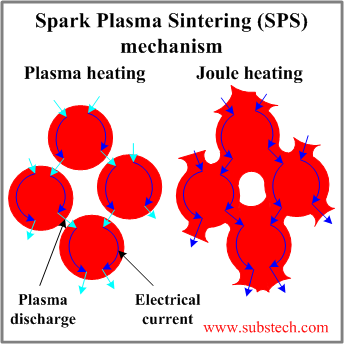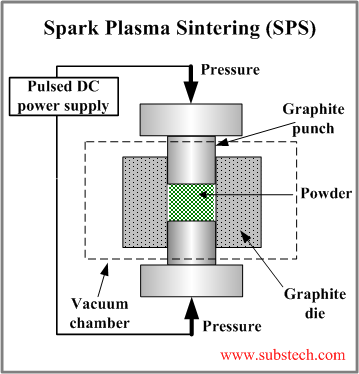Main page
About us
Sliding Bearings Consulting
Advertising Opportunities

to Ceramics
Spark plasma sintering
Dr. Dmitri Kopeliovich
Spark plasma sintering (SPS) or pulsed electric current sintering (PECS) is a sintering technique utilizing uniaxial force and a pulsed (on-off) direct electrical current (DC) under low atmospheric pressure to perform high speed consolidation of the powder.
Spark plasma sintering mechanism
 The mechanism of the spark plasma sintering is still unclear therefore the process name pulsed electric current sintering (PECS) should be considered as more correct.
The mechanism of the spark plasma sintering is still unclear therefore the process name pulsed electric current sintering (PECS) should be considered as more correct.
However commercially the name SPS (spark plasma sintering) is more common.
The most accepted mechanism of the pulsed electric current sintering (PECS)is based on the micro-spark discharge in the gap between neighboring powder particles.
The spark plasma sintering process proceeds through three stages:
- Plasma heating.
The electrical discharge between powder particles results in localized and momentary heating of the particles surfaces up to several thousands ºC.
Since the micro-plasma discharges form uniformly throughout the sample volume the generated heat is also uniformly distributed.
The particles surfaces are purified and activated due to the high temperature causing vaporization of the impurities concentrated on the particle surface.
The purified surface layers of the particles melt and fuse to each other forming “necks” between the particles.
- Joule heating.
At this stage the pulsed DC electrical current flows from particle to particle through the necks connecting them. The joule heat is generated by the electrical current. The joule heat increases the diffusion of the atoms/molecules in the necks enhancing their growth.
Localized character of heating and its uniform distribution allow rapid temperature rise and drop, which diminish coarsening (growth) of the material grains.
- Plastic deformation.
The heated material becomes softer and it exerts plastic deformation under the uniaxial force.
Plastic deformation combined with diffusion result in the densification of the powder compact to over 99% of its theoretical density.
to top
Spark plasma sintering technique
 Spark plasma sintering (SPS) is performed in a Graphite die.
Spark plasma sintering (SPS) is performed in a Graphite die.
The mechanical scheme of the process is similar to the Uniaxial (Die) Pressing.
The load (commonly up to 15000 psi/100 MPa) is transferred to the powder through the upper punch.
The pulsed DC power supply is connected to the upper and lower punches/electrodes.
The pulsed DC electrical current parameters:
- Voltage: few volts;
- Current: several thousands amperes;
- DC pulse time: few to tens of ms;
- DC pause time: few to tens of ms;
The process is conducted under either low pressure (vacuum) or inert gas atmosphere.
Spark plasma sintering process is fast. Its overall duration is commonly 5-20 minutes.
Since only surface layers of the powder particles are heated in the spark plasma sintering process, the average (monitored) temperature of the compact is relatively low: few hundred ºC lower than in conventional sintering process.
to top
Advantages and disadvantages of spark plasma sintering
Advantages of spark plasma sintering:
- Fast sintering process;
- Uniform sintering;
- Low grain growth (nano-grain materials may be prepared);
- Compaction and sintering stages are combined in one operation;
- Binders are not necessary;
- Better purification and activation of the powder particles surfaces;
- High energy efficiency;
- Easy operation.
Disadvantages of spark plasma sintering:
- Only simple symmetrical shapes may be prepared;
- Expensive pulsed DC generator is required.
Related internal links


